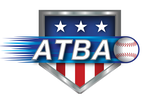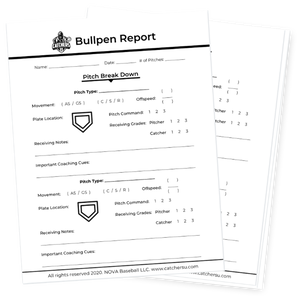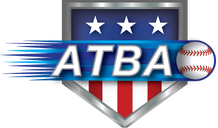|
Catchers take great pride in their pitching staff. Knowing the ins and outs of a pitching staff is crucial to the success of a catcher in their ability to receive and call a great game. The amount of information a catcher needs to know and be able to apply in a competitive environment can be overwhelming. The focus of this article will be to give catchers tools to help them break down, record, and get assistance when developing their plan when it comes to their staff.
Bullpens are the most game like experience catchers have with their pitchers in a practice setting. The ability to create a dialogue with your pitching staff/coach can make all the difference when it comes to everyone being on the same page. Charting your pitchers is a way to write down information that you can study and communicate with the rest of the battery. Writing down information about each pitch will focus you more during the bullpen. My catchers utilize what is called the Bullpen Report (available for free at www.catchersu.com). The bullpen report is an efficient way to write down information and be able to share what you see. Catchers fill out a new report for every bullpen, for every pitcher. Every pitcher is different and this is a way to allow catchers to document and create an individual report for every pitcher on the staff. The report focuses on each pitch the pitcher throws. For example: a pitcher with a 3 pitch mix Fastball, Curveball, and Changeup catchers would fill out information on those 3 pitches on their report. Catchers write down the Pitch Type: Fastball (as pitchers get older two different reports for 4-seam/2-seam). The next category is the type of movement and general location: Armside/Gloveside and does the ball Cut/Run/Sink . If an off speed pitch then there is a clock where catchers can put the type of break (12/6) the pitch has. The next part is a picture of the plate where catchers can make bullets where the pitcher threw each pitch consistently. Catchers then grade the pitch command in how well the pitcher executed each pitch in that bullpen with 1 being the highest. Receiving Notes/Important Coaching Cues are personal notes that catchers put down to help them to have success on that pitch. Writing down the coaching cues that a pitcher hears in a bullpen is a great way to provide comfort in a game by repeating those cues to your pitcher. The last part of the Bullpen Report that I personally love is the Receiving Grades: where a catcher will grade how they thought they received each pitch type. Then the pitcher gives the catcher a grade. This is where dialogue is created. Pitcher may say something about how the catcher set up, glove placement, how they received it. The catcher can then provide why they did what they did or take that feedback and make the change. Creating the conversation is the hardest part when it comes to the pitcher/catcher relationship. This form makes this conversation part of the preparation routine. Charting bullpens and breaking down pitches also allows other catchers to share information so that the preparation and game plan can stay the same regardless of who is behind the plate. Catching is a servant leadership position taking the time to chart and then providing feedback and receiving feedback gives catchers credibility to lead their pitchers during the game. Catchers who do not invest their time into their pitching staffs and are not able to communicate what they see will always struggle getting their pitchers to trust them. Catchers who earn their pitchers trust will see their pitchers best stuff much more consistently than catchers who do not earn that trust.
0 Comments
Leave a Reply. |
Jack FerrickJack Ferrick is an award winning baseball coach and instructor from Northern Virginia with over 15 years of experience. He is highly regarded as a premier catching instructor and has helped numerous players continue beyond the high school level through coaching and his company Catchers U. Jack played two seasons at the United States Naval Academy before a short stint in the Navy. Jack enters his eighth season as the head coach for Osbourn Park High School and also serves as an associate scout for the Milwaukee Brewers. ArchivesCategories |



 RSS Feed
RSS Feed
